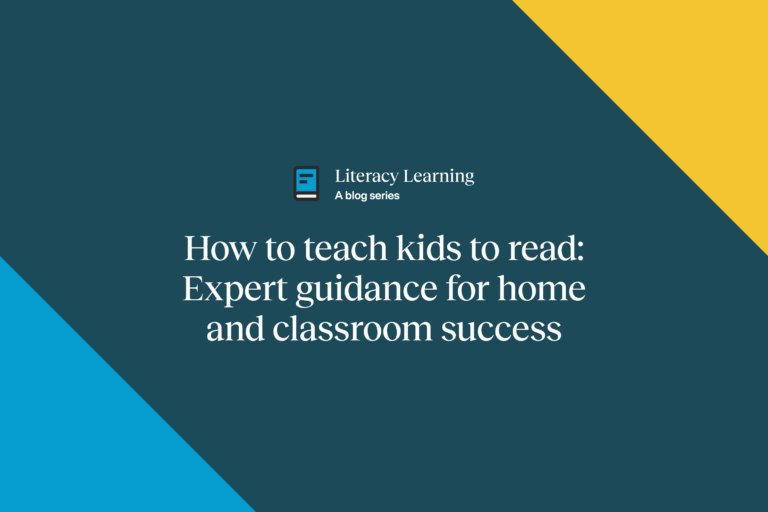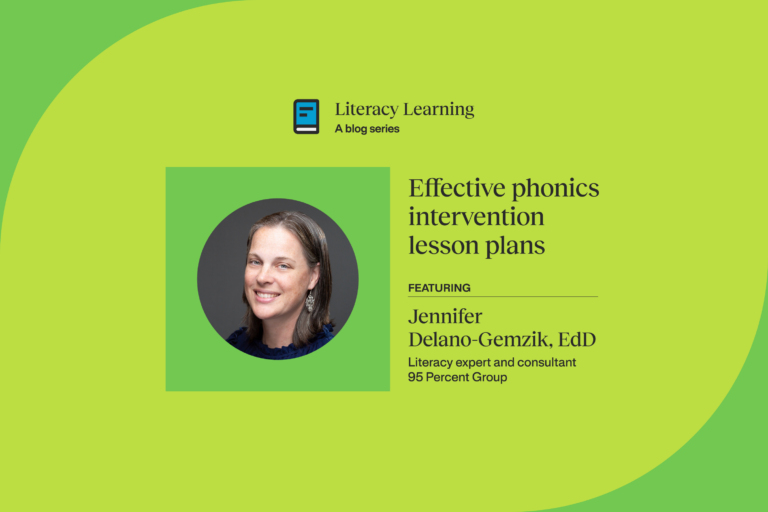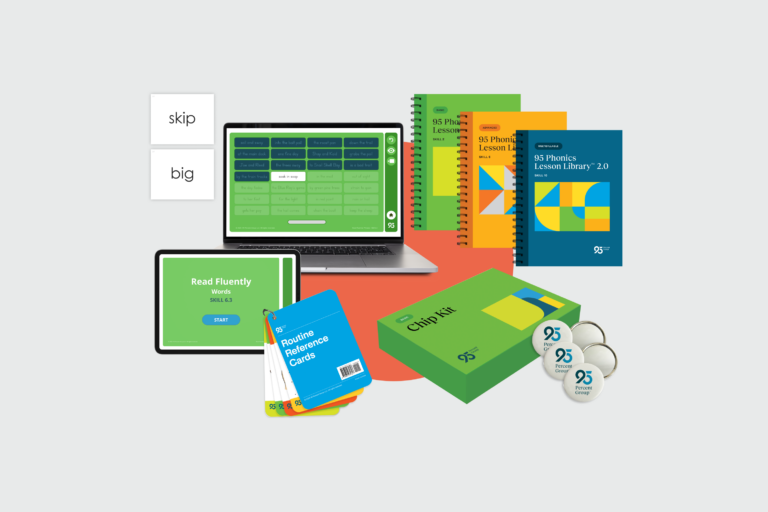20 phonemic awareness activities for students

Phonemic awareness is a foundational skill in learning to read. You could think of it as one of the first steps on the journey of reading skill development. Research has shown that teaching phonemic awareness to young children significantly increases their later reading achievement (Cunningham, 1989; Foorman, Francis, Fletcher, Schatschneider, & Mehta, 1998; Lundberg, Frost, & Peterson, 1988). And mastery of phonemic awareness is one of the strongest predictors of later reading success.
“Perhaps the most critical and least-practiced component of effective early instruction is phoneme awareness. Awareness of the sounds that make up spoken words, facility at manipulating those sounds, and the links between speech and print must be mastered for students to be fluent readers and accurate spellers of an alphabetic writing system like ours.”
Dr. Louisa Moats
What is phonemic awareness?
Phonemic awareness is the ability to identify, say, and manipulate the smallest sounds in words—the phonemes. Phonemes are represented in the written language by graphemes. Graphemes can be individual letters or groups of letters that represent single sounds. For example, sheep has three sounds or phonemes /sh/ /ē/ /p/ represented by the graphemes: sh, ee, and p. Phonemes and syllables are not the same thing—the word salt is one syllable but has four phonemes (/s/ /a/ /l/ /t/).
Phonemic awareness is a subset of phonological awareness. These terms are frequently confused. The guide How Children Learn to Read (World Bank Group, 2022) suggests thinking of a nested set of concepts—with phonemic awareness nested within phonological awareness, and phonological awareness nested in the broader term, phonological processing. Here’s the set of definitions they provide:
- Phonological processing: Many aspects of speech and language perception and production, such as perceiving, interpreting, storing (remembering), recalling or retrieving, and generating the speech sound system of a language.
- Phonological awareness: Conscious awareness of all levels of the speech sound system, including word boundaries, stress patterns, syllables, parts of syllables, and phonemes
- Phonemic awareness: Conscious awareness that words are made up of segments of our own speech that are represented with letters in an alphabetic writing system
Think of phonemes as the sound of speech that can be represented with letters rather than the sounds that letters make.
- Here is a short video that demonstrates the 44 phonemes in the English language.
Why phonemic awareness matters
Teaching students to identify and manipulate the sounds in words helps build a strong foundation for phonics instruction. Research in the science of reading over many years has shown that a child’s success with phonemic awareness is a powerful predictor of later reading success.
In the report Phonemic awareness and phonics for reading and spelling, the authors write:
“The US National Reading Panel (NICHD, 2000) showed that for students of all abilities, teaching phonemic awareness leads to improvement in reading, and that it is most effective when students are explicitly and systematically taught to manipulate phonemes with letters.”
Supporting prior knowledge and sequence of instruction
The report continues (p. 10): “There is also evidence that shows a positive relationship between student’s knowledge of larger sound elements and later success in reading and spelling (Lonigan, 2006). Teaching awareness of words, syllables, and rhyming is important at the earliest levels as it helps students attend to and work successfully with words and larger parts of words, before they are able to work at the phoneme level. Knowledge of syllables and rimes is also important later on for developing the reading, spelling and word study abilities of all students.”
Although mastery of those larger units is not required to teach at the phoneme level, important prior knowledge and learning experiences include:
- Experience of a rich oral language and literacy environment
- Participation in a variety of experiences involving songs, rhymes, oral language games, storytelling, and book sharing sessions
- Some knowledge of phonological awareness: words, syllables, and rhyming
Phonemic awareness can be broken down into a hierarchical set of related skills. The skills are ordered from easiest to most difficult:
- Alliteration – the ability to identify words that begin with the same phoneme: bat, big
- Isolation of the first phoneme – the ability to identify and say the initial phoneme in words: for example, /c/ in cat, car
- Isolation of the final phoneme – the ability to identify and say the final phoneme in words: for example, /g/ in dog, pig
- Isolation of the medial phoneme – the ability to identify and say the middle phoneme in words: for example, /o/ in cot, dog
- Phoneme blending – the ability to merge phonemes together to articulate a word: /c/ /a/ /t/ makes cat
- Phoneme segmentation – the ability to break up and articulate the individual phonemes in a word: the phonemes in cat are /c/ /a/ /t/
- Phoneme manipulation – the ability to delete or substitute a given phoneme in any position within a word: take away the /i/ in slip and replace it with /a/
How can teachers and parents help children strengthen phonemic awareness?
Mastering phonemic awareness involves a developmental progression for young children. For example, research shows that identifying beginning and ending phonemes is easier than identifying medial phonemes (Inverizzie, 2003). The NRP research review emphasizes the need for explicit, sequential, systematic, and comprehensive phonemic awareness instruction.
Phonemic awareness instruction typically spans kindergarten and first grade. Oral activities in kindergarten focus on simple tasks such as rhyming, matching words with beginning sounds, blending phonemes into words (“Blend these phonemes together /m/ /a/ /n/), and segmenting words into phonemes (“What are the phonemes in man?). In first grade, phonemic awareness tasks become more advanced, continuing a focus on blending and segmentation, while adding the substitution and manipulation of phonemes (e.g., Change the first phoneme in man to /r/. What word do you have?”). Phonemic awareness activities are done orally, with a gradual introduction of the graphemes that represent them.
Most of these activities can be adjusted for older students in second grade and up who need to develop their phonemic awareness skills. Reading Rockets offers specific guidelines for planning developmentally appropriate phonemic awareness activities in sequence here.
Tips for making phonemic awareness activities fun
Use a multisensory approach to make it fun and interactive for all ages of students. For example, you can use:
- rhyming games
- songs
- movement activities
- storytelling and role-play
- soft toys*
Research shows that phonemic awareness activities for students should be kept short and engaging (10-20 minutes).
*Note: Many educators recommend using soft toys instead of puppets so that children can watch the adult’s face and mouth articulate the sounds directly.
A few basic terms defined
- Phonograms: Phonograms are the common elements in word families (e.g., the letter sequence “and” in sand, hand, band, and land).
- Onset and rime: The initial consonant that changes the meaning of the word is called an onset and the following vowel/consonant combination that remains constant is called a rime.
An awareness of syllables, onsets, and rimes develops before an awareness of phonemes (Goswami, 1994, p. 36), so the first activities focus on ways to expose children to these through various forms of word play.
Source: Reading Rockets
Phonemic awareness activities
In planning phonemic awareness activities, it’s important to consider the developmental requirements. Edwin S. Ellis writes in a Reading Rockets post:
“For example, when teaching children to partition words into parts, segmenting a compound word into its two parts (“What two words do you hear in cowboy?”) precedes segmenting syllables and sounds.
Similarly, identification tasks (“Which one doesn’t rhyme — cat, hat, sun?”) are generally easier than production tasks (“Tell me the first sound in car”). The difficulty level of most activities can be manipulated by changing the input or response modes. For example, “Find the picture that starts with /r/” will be easier than “What sounds do you hear in robe?”
You’ll find a set of guidelines to keep in mind when planning instructional activities in the post, How Now Brown Cow.
Here are 20 fun and engaging activities for young children, as well as several activities for older students that can be adapted for home or school.
1. Speech sounds through music and rhymes
Songs and children’s literature and poetry can offer a playful way to expose children to the sounds in speech. Edwin S. Ellis writes, “Simple rhyme patterns are easily recalled after repeated exposure, and children will get the idea of creating new rhymes…Some books include music to go with the rhymes, such as Down by the Bay (Raffi, 1987), in which two children try to outdo one another in making up questions that rhyme, such as “Did you ever see a goose kissing a moose?”
Source: Edelen-Smith, P. J. (November, 1997). How Now Brown Cow: Phoneme Awareness Activities for Collaborative Classrooms. Intervention in School and Clinic, Volume 33, Number 2, pp. 103-111. Copyright by PRO-ED, Inc.; Reading Rockets.
2. Syllable awareness—syllable shopping
While at the grocery store, have your child tell you the syllables in different food names. Have them hold up a finger for each word part. Eggplant = egg-plant, two syllables. Pineapple = pine-ap-ple, three syllables. Show your child the sign for each and ask her to say the word.
- To adapt for the classroom, bring in some fruit and vegetables in advance.
- Then, you can say “Let’s pretend we’re at the grocery store.”
- Carry on from there.
Source: Reading Rockets
3. Syllable awareness—stomp and say
Stomp and Say helps students practice segmenting and counting syllables in words. Use hands to “stomp” each syllable of a word. Kids listen, watch, and count the stomps. Then have kids do it with you. And last, have kids do it themselves.
- Watch this video demo from Reading Universe here.
4. Onset-rime—rime house
In this activity a parent and child sort words into rime families using several Rime House workboards and picture cards. The FCRR “At Home” series was developed especially for families.
- Watch the video here
- Download the work boards and picture cards on the activity sheet here
- See all FCRR phonological awareness activities here
Source: Florida Center for Reading Research (FCRR)—from the “At Home” series for families
5. Onset-rime—guessing game
Students work in pairs using picture cards and onset and rime clues to guess words. Students alternate drawing picture cards. The student who draws the card gives the clues one at a time (e.g., “It begins with /r/ and rhymes with bug”) until student guesses a word (i.e., “rug”). Then they reverse roles.
Source: Florida Center for Reading Research (FCRR)
6. Initial phoneme identification—treasure box
Send students on a treasure hunt around the classroom or the outside area looking for objects starting with a particular sound, for example /t/, and saying /t/, /t/ as they look. When they have found something they think starts with /t/, they place it in a treasure box. With the teacher (or parent or caregiver), they decide if each object begins with /t/ and should stay in the treasure box.
7. Phoneme isolating—Sound Quest game
Students sort pictures according to initial, medial, and final sounds. Using double-picture cards, students individually determine if the two pictures share the same initial, medial, or final sound.
- Download instructions and picture cards here.
Source: Florida Center for Reading Research (FCRR)
8. Phoneme blending—blending i-Spy
This is a very common game that you can adapt in a number of ways for different ages. A teacher or parent/caregiver begins by modeling, “I spy a /h/ /a/ /t/. What do I spy? Yes, it is a hat!”
Adjust the level of difficulty as the student’s blending skills develop.
In the home, this game could be played in the kitchen (I spy a /c/ /u/ /p/) or on a walk (I spy a /dog/, I spy a /c/ /a/ /t/).
Source: Scholastic Red and Reading Rockets
9. Blending—blend baseball
Divide the class into two teams. Say aloud a word in parts (syllable by syllable, onset/rime, or phoneme by phoneme). For example, say “/s/ /a/ /t/.” If the child that is “up at bat” can blend the word, he or she advances to first base. The next batter comes up, and the game continues just like baseball.
Source: Scholastic Red and Reading Rockets
10. Blending—shout it out song
Students sing to the tune of “If You’re Happy and You Know It, Clap Your Hands.”
If you think you know this word, shout it out!
If you think you know this word, shout it out!
If you think you know this word,
Then tell me what you’ve heard,
If you think you know this word, shout it out!
After singing, the teacher says a segmented word such as /k/ /a/ /t/ and students provide the blended word “cat.”
Source: (see Yopp, M., 1992) via Reading Rockets
11. Blending and segmenting—robbie the robot
This activity uses a picture of a robot as a stimulus for explaining the concepts of blending and segmenting. Robbie the Robot can only say words one sound at a time, which requires students to blend sounds to figure out what he said. He can also only “understand” words when the student says them one sound at a time, which requires the child to segment sounds. For young children, this explanation of blending and segmenting tends to be very accessible.
- Download lesson (PDF) with image (Google slides and Powerpoint) of Robbie here
Source: University of Florida Literacy Institute
12. Phoneme segmenting—bead slide tool
This activity can be adapted from simple to more complex (2 phoneme words to 6 phoneme words). Children move a bead on a string from one side to the other for every sound they hear in a word.
PDF with x and instructions to make your own bead slide in the video 3:13
- Watch the video to make your own bead slide here
- Download a “cheat sheet” with 2, 3, 4, 5, and 6 phoneme words here
Source: Julie Van Alst of Make, Take & Teach
UFLI provides a digital version of the bead slide tool.
- Watch a video tutorial here.
- Download slides (Powerpoint and Google Slides).
Source: UFLI
13. Phoneme segmenting—segmentation cheer
Write the “Segmentation Cheer” on chart paper, and teach it to children. Each time you say the cheer, change the words in the third line. Have children segment the word sound by sound. Begin with words that have three phonemes, such as ten, rat, cat, dog, soap, read, and fish.
The Cheer
Listen to my cheer.
Then shout the sounds you hear.
Sun! Sun! Sun!
Let’s take apart the word sun.
Give me the beginning sound. (Children respond with /s/.)
Give me the middle sound. (Children respond with /u/.)
Give me the ending sound. (Children respond with /n/.)
That’s right!
/s/ /u/ /n/—Sun! Sun! Sun!
Source: Scholastic Red via Reading Rockets
14. Segmenting phonemes—Elkonin boxes for 2, 3, 4, 5 phonemes
An Elkonin box is a tool that helps children segment words into phonemes. D.B. Elkonin, a Russian psychologist, pioneered their use. Students count sounds in each word first, and move a chip into each box to represent each sound.
You’ll find a tutorial, sample lesson, and Google slides and Powerpoints here.
Source: UFLI
15. Segmenting and blending—phoneme detective
This detective game is played with a partner to practice segmenting and blending. Students take turns being the “Segmenter,” whose job is to say the individual phonemes of a word out loud for the other student, and the “Blender,” who blends the sounds together to guess the word.
- Download the PDF with instructions and picture cards here
Source: Reading Universe
16. Phoneme manipulation—deletion, addition, substitution
Phoneme manipulation is an advanced phonemic awareness skill that follows blending and segmenting. Begin with playful deletion activities, followed by addition, and then substitution. You’ll use manipulatives like felt squares to represent phonemes. This avoids distracting students with printed letters and words initially. Use an “I do, We do, You do” gradual release process. Download lesson plans here:
You’ll find a video of substitution in the classroom here.
Source: Reading Universe
17. Phonemic awareness practice—say it-move it
Say it-move it is an instructional routine that can be used at all levels of phonemic awareness development. For beginners, have the student simply move a chip for each sound (as with Elkonin boxes). For more advanced students, present challenges by having them manipulate sounds within a word (e.g., lip → lips → slip → slap → laps).
Source: University of Florida Literacy Institute
18. Sound-chaining routine for initial sounds
Sound-chaining activities promote more accurate reading and spelling. Here is an example for sound-chaing initial sounds in words. Say “dot.” Now say the word slowly, stretching out the sounds. Place one chip down as you say each sound. Change the /d/ to /g/. Point to the sound that changes. What sound is leaving? What is the new sound? Blend the sounds to make the new word. Student says “got.” Now change the /g/ to /l/. Point to the sound that changes. What sound is leaving? What is the new sound? Blend the sounds to make the new word. Student says “lot.” Once students can sound chain words with three-phoneme words confidently, sound chaining activities with four-sound words can help them perceive sound differences among similarly spoken words (e.g., fright, flight, and fight).
Source: Teaching Phoneme Awareness in 2023: A Guide for Educators
19. Phonemic awareness practice—4th & 5th grade
North Carolina Department of Public Instruction offers several activities for parents to support 4th and 5th grade students in phonemic awareness. Activities include phoneme isolation of initial and final sounds, onset and rime, phoneme blending, and adding, deleting, and substituting phonemes.
Download a Google slide deck here for activities here.
Source: North Carolina Department of Public Instruction
20. Phoneme-grapheme connection—Sound Walls
Many educators are transitioning from Sound Walls to Word Walls. Word Walls are organized alphabetically, from A to Z and focus on letters. Sound Walls, like the name, are organized around the sounds in speech, and focus on phonemes and articulation. Educator Marjorie Bottari writes about making the transition from her word wall to a sound wall: “Asking students to recall how to read and spell a word based on letter names rather than sounds was like asking them to memorize a suggested password. There is nothing to anchor the learning, and that’s not the way our language works.”
Marjorie offers detailed instructions on how to create a sound wall here.
Putting phonemic awareness activities into action
According to the authors of Teaching Phoneme Awareness in 2023: A Guide for Educators (Ashby, J., McBride, M., Naftel, S., O’Brien, E., Paulson, L. H., Kilpatrick, D. A, & Moats, L. C., 2023):
“Phonemic awareness activities strengthen and sharpen phonological processing and, therefore, are crucial for many students who are beginning to read as well as struggling readers. Phonemic awareness instruction helps readers perceive the sound sequences in words accurately, which is necessary for learning the letter-sound patterns in phonics and for remembering decoded words. Comparisons of present research indicate larger reading gains for students when lessons include phonemic awareness as well as phonics…Students who identify sounds in spoken words easily can learn the phonics skills that support accurate decoding and spelling, which, in turn, supports memory for written words.”
95 Phonemic Awareness Suite™—research-based phonemic awareness instruction
95 Phonemic Awareness Suite™ is a new, comprehensive phonemic awareness solution that includes Tier 1 instruction, assessment, differentiated Tier 2 instruction, and professional learning—all aligned to provide a consistent instructional dialogue for teachers and students. Aligned with the latest research on phonemic awareness, it’s everything needed to build critical foundational skills and set students up for reading success!
95 Phonemic Awareness Suite components include:
- Tier 1: 95 Pocket Phonemic Awareness™, 50 weeks of lessons, each 10 minutes per day (K-1)
- Assessment: 95 Phonemic Awareness Screener for Intervention™
- Tier 2: 95 Phonemic Awareness Intervention Resource™, lessons cover alphabetic & phonemic awareness, with Kid Lips instruction built-in
- Professional learning for teachers and reading specialists
Learn more
Are you interested in learning about how you can bring an effective and efficient structured literacy approach, grounded in the science of reading, to your school or district? Contact us today.



